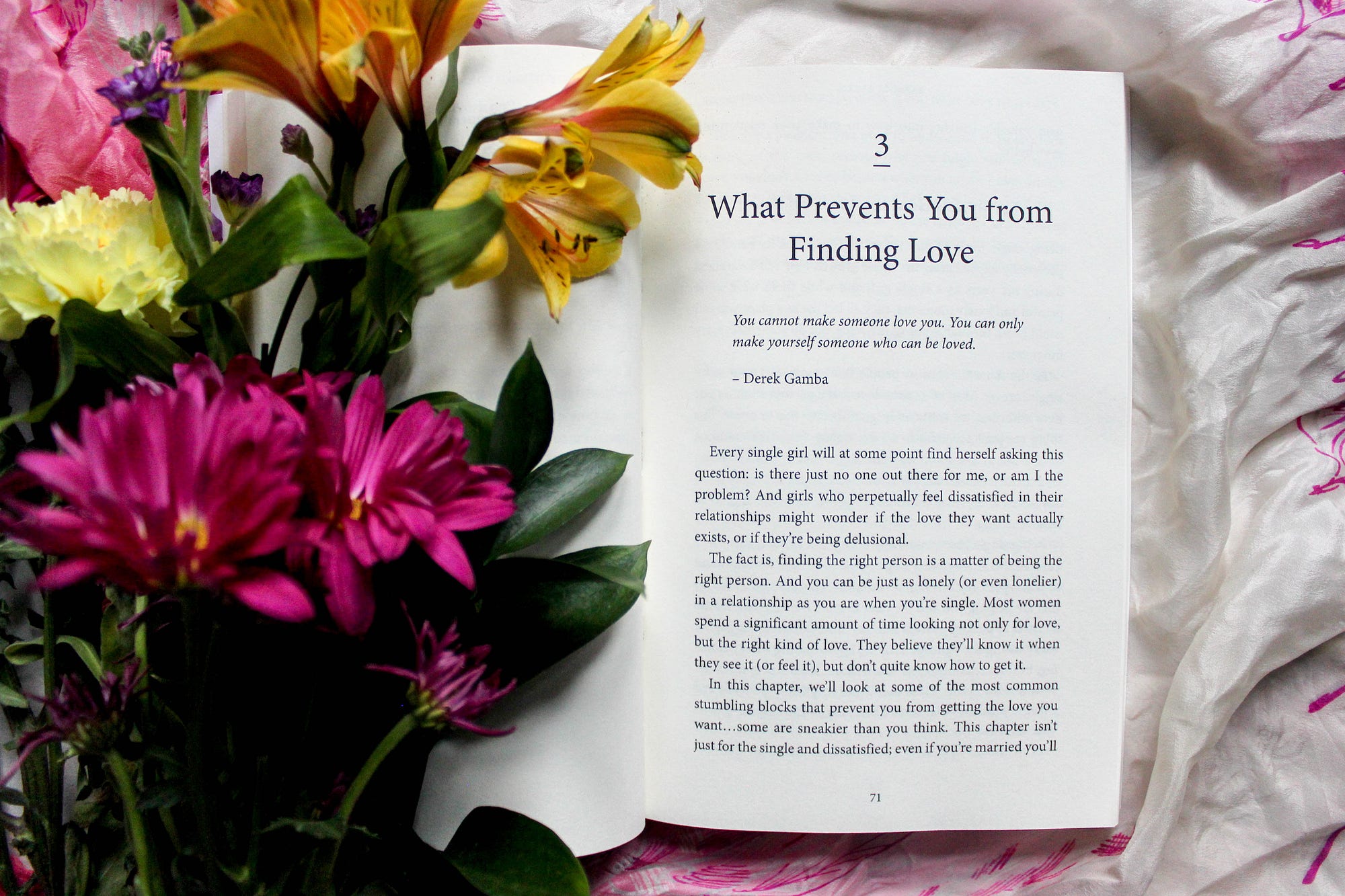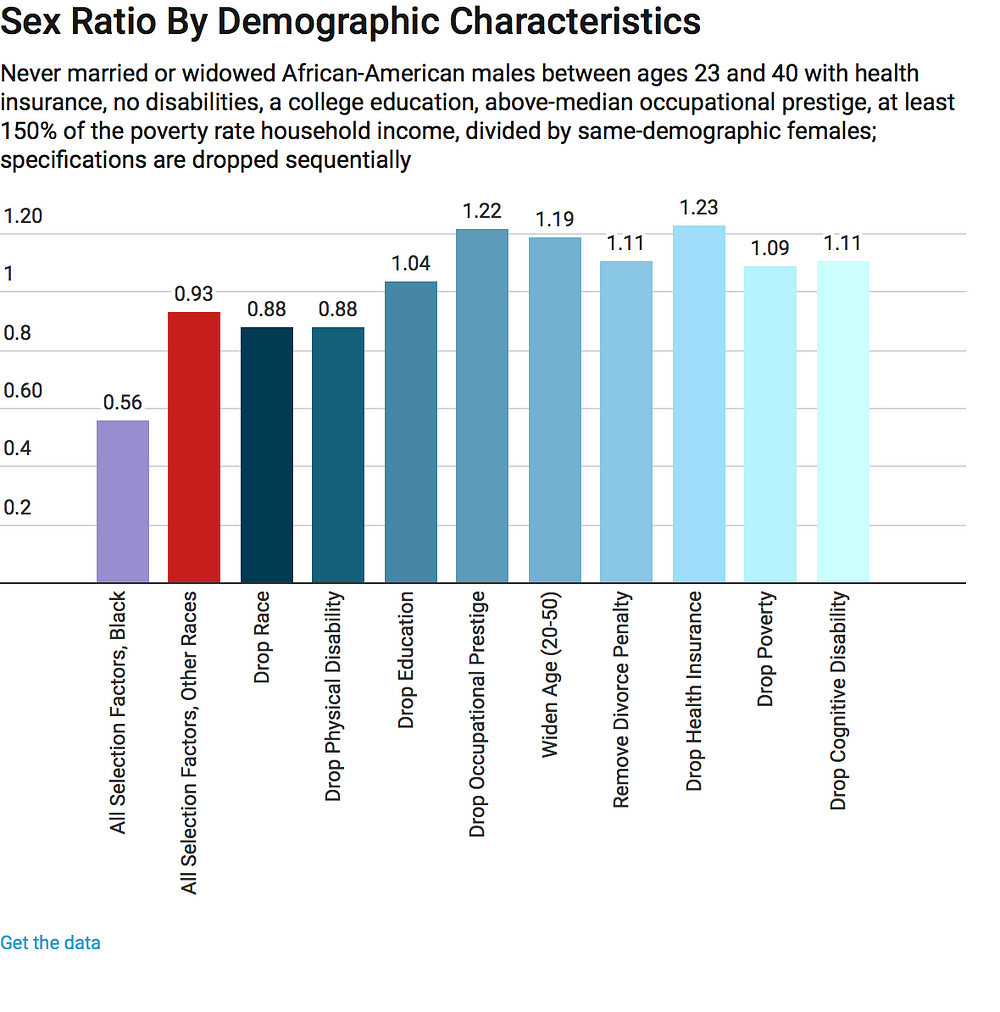The Marriage Market May Be More Imbalanced Than You Think

Let’s look at some geographic markets for dating. This will be a very short post, simply because I was interested in the topic.
I
will mostly look at this question from a female perspective, that is,
“men per woman,” merely out of convenience. For the male perspective,
simply take the inverse of all ratios given.
It’s
common to simply look at the sex ratio and assume that’s an indicator
of how balanced or imbalanced marriage markets may be. But that’s
actually a bad indicator, because it can conceal big differences by age.
But also, marriage is selective: people tend to marry others of the
same socioeconomic class. Furthermore, when it comes down to it,
peoples’ reveal preferences in dating markets are really shameful: the
average person prefers not to date or marry those who are different
races, poor, or disabled. This is a sad testament to our society.
It also means that when we want to estimate what the marriage and
dating market looks like across space, we really need to segment by
subgroups.
Let’s
start with a really narrow subgroup. Let’s say that you are a
20-something woman. You have a college degree and a reasonably
high-status career. You’ve got your own health insurance, you’re not in
poverty, and you’re not seriously mentally or physically handicapped.
Assuming you, like most of your same-demographic, would prefer all else being
equal, to marry somebody of your same demographic… how many options do
you have in your metro area? Put another way: of all the women in your
demographic, how many men are there to go around for each of you?
Now, note that I would make an adjustment for sexuality too, but the American Community Survey does not ask about sexuality.

Pretty
straightforward! High-achieving, non-disabled,
gainfully-employed-in-prestigious-occupation young women massively
outnumber men in most metro areas. The midwest and the Pacific coast
have some man-heavy cities, but, by and large, for these choosey young
professionals, “suitable” men are in short supply.
The story is even rougher for high-achieving African-American women.

There
are some sample-size problems here with the ACS. But the reality is,
there are cities where the ACS estimate, in a very big survey, of the
number of black men who fit these criteria is zero. The legacy of incarceration, segregation, and ultimately slavery is incredibly powerful.
For
the whole nation, there are 0.56 of these non-disabled, high-achieving
young black men per same-demographic woman, versus about 0.93 for all
other women.
In
other words, for white and Asian women, there is a real gender
imbalance in this high-status, most-marriagable group… but it isn’t
extremely severe. Probably no more than 7% of women would have to “marry down” assuming direct matching within the group. Local gender imbalances can sometimes be substantial, but, on the whole, national marriage markets should clear.
But for black women, nearly half of
high-achieving black women will probably have to “marry down,” or not
marry at all. In some cities, eligible black bachelors are statistically
nonexistent.
But
I’ve made some callous assumptions about the marriage market, haven’t
I? It’s a bit unfair to say that somebody would avoid dating a disabled
person; that seems slanderous about these high-achieving young men and
women. Now, of course, disability rights advocates would probably be
quick to point out that, yes, ablist discrimination is an extremely real
thing in dating, but, let’s be charitable. Let’s assume non-disabled
people don’t care about physical disability.
And
maybe I’ve been unkind on other counts too. Maybe people will marry
across a wider range of educational and occupational difference, or age
ranges. Maybe there’s no penalty in the marriage market for prior
divorces. Maybe so!
So here’s the sex ratio, nationally, for progressively wider-and-wider specified groups.

The
black-vs-other gap is stark and dramatic, and it’s hard to believe this
isn’t basically a story of mass incarceration. Beyond that, we can see
that education is a big factor. The “Drop Education” bar shows that, if a
given woman wants a spouse who is a close-age-peer, has a relatively
prestigious occupation, has never been divorced, is not cognitively
disabled, is well above poverty, and has health insurance, her odds are a
lot better if she doesn’t
require a college degree. It turns out, male-dominated prestigious
occupations have lower educational requirements than female ones.
Occupational
prestige also independently boosts the sex ratio. If a given woman
demands that a man have insurance, be well above poverty, not previously
divorced, an approximate age peer, and not be cognitively disabled, but
she doesn’t care whether he has a low status job or a degree, then
there’s actually a substantial bias in favor of men. It turns out, there
are a decent number of men out there who are well above poverty and
basically doing okay, but just in low-status jobs: more than there are
similar-characteristic women, in fact.
Widening
age parameters, however, does not help, because I assume the widening
is symmetric. But if the widening is asymmetric (i.e. women will marry
older men, but men won’t marry older women), then it could help women,
but obviously would make mens’ marriage prospects much worse.
Likewise,
letting divorcees into the marriagable pool pushes sex ratios towards
parity, because, controlling for insuredness, poverty, age, and
cognitive disability, apparently these marginal divorcees skew female.
Surprised me too!
Relaxing
the requirement for health insurance adds a lot more men, suggesting
that the above-poverty cognitively-normative uninsured population is
disproportionately male, but then relaxing the above-poverty requirement
adds in women, suggesting that insured-but-poor people tend to be
female. Finally, cognitive disabilty is slightly male-biased.
This can be flipped on its head to show that, when a man gets a degree, or moves into a higher-status occupation, he enters a much more favorably skewed marriage and dating market.
In
other words, when you think about whether your city has “marriagable”
people, think about the requirements you’re setting. Individual
requirements (“I want a spouse with a college degree”) can end up being
hugely significant. And I didn’t even include religious or social values
in there! With those added, you can get even more severe imbalances,
since religiosity skews female as well. The largest factors driving the
sex ratio are race (proxying for incarceration most likely), education,
and occupational class, each independently driving part of the effect.
Comments
Post a Comment